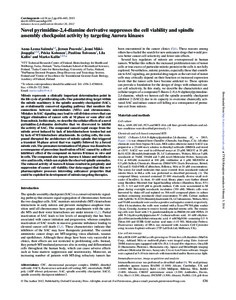Novel pyrimidine-2,4-diamine derivative suppresses the cell viability and spindle assembly checkpoint activity by targeting Aurora kinases
Kohonen P; Kallio M; Pouwels J; Maki-Jouppila J; Kallio L; Salmela AL; Toivonen P
Novel pyrimidine-2,4-diamine derivative suppresses the cell viability and spindle assembly checkpoint activity by targeting Aurora kinases
Kohonen P
Kallio M
Pouwels J
Maki-Jouppila J
Kallio L
Salmela AL
Toivonen P
OXFORD UNIV PRESS
Julkaisun pysyvä osoite on:
https://urn.fi/URN:NBN:fi-fe2021042714545
https://urn.fi/URN:NBN:fi-fe2021042714545
Tiivistelmä
Mitosis represents a clinically important determination point in the life cycle of proliferating cells. One potential drug target within the mitotic machinery is the spindle assembly checkpoint (SAC), an evolutionarily conserved signaling pathway that monitors the connections between microtubules (MTs) and chromosomes. Mistakes in SAC signaling may lead to cell division errors that can trigger elimination of cancer cells at M phase or soon after exit from mitosis. In this study, we describe the cellular effects of a novel pyrimidine-2,4-diamine derivative that we discovered to inhibit the activity of SAC. The compound caused rapid escape from the mitotic arrest induced by lack of interkinetochore tension but not by lack of MT-kinetochore attachments. In cycling cells, the compound disrupted the architecture of mitotic spindle that triggered a transient M-phase arrest that was rapidly followed by a forced mitotic exit. The premature termination of M phase was found to be a consequence of precocious inactivation of SAC caused by a direct inhibitory effect of the compound on Aurora B kinase in vitro and in cells. The compound also targets Aurora A kinase and tubulin in vitro and in cells, which can explain the observed spindle anomalies. The reduced activity of Aurora B kinase resulted in polyploidy and suppression of cancer cell viability. Our data suggest that this new pharmacophore possesses interesting anticancer properties that could be exploited in development of mitosis-targeting therapies.
Kokoelmat
- Rinnakkaistallenteet [19218]
